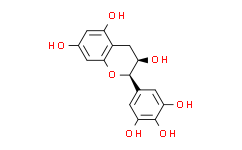包装规格:
100mg 250mg 1g in glass bottle
产品简介:
一种从啤酒花中分离到的黄酮类化合物,是 DGAT,COX-1 和 COX-2 的抑制剂,具有抗肿瘤,抗血管生成的作用。Xanthohumol 还具有抗牛病毒性腹泻病毒 (BVDV),鼻病毒,HSV-1,HSV-2 和 巨细胞病毒 (CMV) 的抗病毒活性。
溶解性:
DMSO :83.33 mg/mL(235.13 mM;超声助溶)
储备液保存:
-80°C 2 years
-20°C 1 year
-20°C 1 year
体内实验:
1、请依序添加每种溶剂:10% DMSO→40% PEG300→5% Tween-80→45% Saline
Solubility: ≥ 2.08 mg/mL (5.87 mM); 澄清溶液
此方案可获得 ≥ 2.08 mg/mL(饱和度未知)的澄清溶液。
以 1 mL 工作液为例,取 100 μL 20.8 mg/mL 的澄清 DMSO 储备液加到 400 μL PEG300 中,混合均匀;再向上述体系中加入 50 μL Tween-80,混合均匀;然后再继续加入 450 μL 生理盐水 定容至 1 mL。
2、请依序添加每种溶剂:10% DMSO→90% (20% SBE-β-CD in Saline)
Solubility: ≥ 2.08 mg/mL (5.87 mM); 澄清溶液
此方案可获得 ≥ 2.08 mg/mL(饱和度未知)的澄清溶液。
以 1 mL 工作液为例,取 100 μL 20.8 mg/mL 的澄清 DMSO 储备液加到 900 μL 20% 的 SBE-β-CD 生理盐水水溶液 中,混合均匀。
<1mg/ml表示微溶或不溶。
普西唐提供的所有化合物浓度为内部测试所得,实际溶液度可能与公布值有所偏差,属于正常的批间细微差异现象。
请根据产品在不同溶剂中的溶解度选择合适的溶剂配制储备液;⼀旦配成溶液,请分装保存,避免反复冻融造成的产品失效。
Solubility: ≥ 2.08 mg/mL (5.87 mM); 澄清溶液
此方案可获得 ≥ 2.08 mg/mL(饱和度未知)的澄清溶液。
以 1 mL 工作液为例,取 100 μL 20.8 mg/mL 的澄清 DMSO 储备液加到 400 μL PEG300 中,混合均匀;再向上述体系中加入 50 μL Tween-80,混合均匀;然后再继续加入 450 μL 生理盐水 定容至 1 mL。
2、请依序添加每种溶剂:10% DMSO→90% (20% SBE-β-CD in Saline)
Solubility: ≥ 2.08 mg/mL (5.87 mM); 澄清溶液
此方案可获得 ≥ 2.08 mg/mL(饱和度未知)的澄清溶液。
以 1 mL 工作液为例,取 100 μL 20.8 mg/mL 的澄清 DMSO 储备液加到 900 μL 20% 的 SBE-β-CD 生理盐水水溶液 中,混合均匀。
<1mg/ml表示微溶或不溶。
普西唐提供的所有化合物浓度为内部测试所得,实际溶液度可能与公布值有所偏差,属于正常的批间细微差异现象。
请根据产品在不同溶剂中的溶解度选择合适的溶剂配制储备液;⼀旦配成溶液,请分装保存,避免反复冻融造成的产品失效。
靶点:
COX-1
COX-2
HSV-1
HSV-2
DGAT1:40 μM (IC50)
DGAT2:40 μM (IC50)
CMV
COX-2
HSV-1
HSV-2
DGAT1:40 μM (IC50)
DGAT2:40 μM (IC50)
CMV
体外研究:
Xanthohumol significantly attenuates ADP-induced blood platelet aggregation, and significantly reduces the expression of fibrinogen receptor (activated form of GPIIbIIIa) on platelets' surface.
Xanthohumol (5-50 nM) reduces the frequency of spontaneously occurring Ca2+ sparks and Ca2+ waves in control myocytes and in cells subjected to Ca2+ overload caused by: (1) exposure to low K+ solutions, (2) periods of high frequency electrical stimulation, (3) exposures to isoproterenol or (4) caffeine. Xanthohumol (50-100 nM) reduces the rate of relaxation of electrically- or caffeine-triggered Ca2+ transients, without suppressing ICa, but this effect is small and reversed by isoproterenol at physiological temperatures. Xanthohumol also suppresses the Ca2+ content of the SR, and its rate of recirculation.
Treatment of endothelial cells with Xanthohumol leads to increased AMPK phosphorylation and activity. Functional studies using biochemical approaches confirm that AMPK mediates Xanthohumol anti-angiogenic activity. AMPK activation by Xanthohumol is mediated by CAMMKβ, but not LKB1.Analysis of the downstream mechanisms shows that Xanthohumol-induced AMPK activation reduces nitric oxide (NO) levels in endothelial cells by decreasing eNOS phosphorylation. Finally, AKT pathway is inactivated by Xanthohumol as part of its anti-angiogenic activity, but independently from AMPK, suggesting that these two signaling pathways proceed autonomously.
Xanthohumol significantly reduces cell viability and induces apoptosis via pro-caspase-3/8 cleavage and poly(ADP ribose) polymerase (PARP) degradation. Pro-caspase-9 cleavage, Bcl2 family expression changes, mitochondrial dysfunction, and intracellular ROS generation also participate in Xanthohumol-induced glioma cell death. Xanthohumol's inhibition of the IGFBP2/AKT/Bcl2 pathway via miR-204-3p targeting plays a critical role in mediating glioma cell death.
Xanthohumol (5-50 nM) reduces the frequency of spontaneously occurring Ca2+ sparks and Ca2+ waves in control myocytes and in cells subjected to Ca2+ overload caused by: (1) exposure to low K+ solutions, (2) periods of high frequency electrical stimulation, (3) exposures to isoproterenol or (4) caffeine. Xanthohumol (50-100 nM) reduces the rate of relaxation of electrically- or caffeine-triggered Ca2+ transients, without suppressing ICa, but this effect is small and reversed by isoproterenol at physiological temperatures. Xanthohumol also suppresses the Ca2+ content of the SR, and its rate of recirculation.
Treatment of endothelial cells with Xanthohumol leads to increased AMPK phosphorylation and activity. Functional studies using biochemical approaches confirm that AMPK mediates Xanthohumol anti-angiogenic activity. AMPK activation by Xanthohumol is mediated by CAMMKβ, but not LKB1.Analysis of the downstream mechanisms shows that Xanthohumol-induced AMPK activation reduces nitric oxide (NO) levels in endothelial cells by decreasing eNOS phosphorylation. Finally, AKT pathway is inactivated by Xanthohumol as part of its anti-angiogenic activity, but independently from AMPK, suggesting that these two signaling pathways proceed autonomously.
Xanthohumol significantly reduces cell viability and induces apoptosis via pro-caspase-3/8 cleavage and poly(ADP ribose) polymerase (PARP) degradation. Pro-caspase-9 cleavage, Bcl2 family expression changes, mitochondrial dysfunction, and intracellular ROS generation also participate in Xanthohumol-induced glioma cell death. Xanthohumol's inhibition of the IGFBP2/AKT/Bcl2 pathway via miR-204-3p targeting plays a critical role in mediating glioma cell death.
激酶实验:
Cox 活性的抑制:COX-1活性的抑制使用Clark型O2-电极通过监测花生四烯酸转化到PGs期间氧气消耗量测量。反应混合物包含来源于公羊精囊的100 μL线粒体碎片中的∼0.2单元Cox-1作为Cox-1 (比活度0.2–1 units/mg蛋白质)的天然来源,或0.23单元重组人Cox-2 (比活度43 units/mg 蛋白质)。对于计算,O2消耗率与DMSO对照组(100% 活性)比较。Piroxicam,一种非甾体类抗炎化合物,用作Cox-1活性的阳性抑制物质,IC50为0.35 ± 0.05 μM (n = 2)。或者,nimesulide,一种Cox-2特异性抑制剂,在50 μM浓度下抑制52 ± 5.7% (n = 2)的Cox-2活性。
细胞实验:
细胞系:HL-60细胞
浓度:12.5 μM
处理时间:96 h
方法:HL-60细胞维持在RPMI 1640中,用10% FBS增补,置于37°C,5% CO2大气环境下。对数期14–16 h细胞群体倍增时间用于进行实验。连续2倍稀释的化合物(在DMSO中溶解,终浓度为0.1%)以0.2–12.5 μM的终浓度范围在24孔板中使用1 ml RPMI/孔制备。对照孔加入相同量的溶剂。随后,将1 ml细胞悬浮液加入孔中。96小时后,评估实验。细胞数量使用Casy 1 TTC流式细胞计数仪计数。处理细胞的增殖表示为溶剂对照组的百分比。
浓度:12.5 μM
处理时间:96 h
方法:HL-60细胞维持在RPMI 1640中,用10% FBS增补,置于37°C,5% CO2大气环境下。对数期14–16 h细胞群体倍增时间用于进行实验。连续2倍稀释的化合物(在DMSO中溶解,终浓度为0.1%)以0.2–12.5 μM的终浓度范围在24孔板中使用1 ml RPMI/孔制备。对照孔加入相同量的溶剂。随后,将1 ml细胞悬浮液加入孔中。96小时后,评估实验。细胞数量使用Casy 1 TTC流式细胞计数仪计数。处理细胞的增殖表示为溶剂对照组的百分比。
动物实验:
动物模型:CETP-Tg 和 C57BL/6N (野生型)小鼠,TRAMP C57BL/6 小鼠
剂量:50 μg/小鼠
给药处理:p.o.
剂量:50 μg/小鼠
给药处理:p.o.
保存条件:
2-8°C
注意事项:
1、为了您的安全和健康,请穿实验服并戴一次性手套操作。
2、以上信息仅做参考交流之用。
2、以上信息仅做参考交流之用。
UN码:
HazardClass:
危害声明:
安全说明:
搜索质检报告(COA)
参考文献 & 客户发表文献
本计算器可帮助您计算出特定溶液中溶质的质量、溶液浓度和体积之间的关系,公式为:
质量 (g) = 浓度 (mol/L) x 体积 (L) x 分子量 (g/mol)
摩尔浓度计算公式
用本工具协助配置特定浓度的溶液,使用的计算公式为:
开始浓度 x 开始体积 = 最终浓度 x 最终体积
稀释公式
稀释公式一般简略地表示为:C1V1 = C2V2 ( 输入 输出 )








